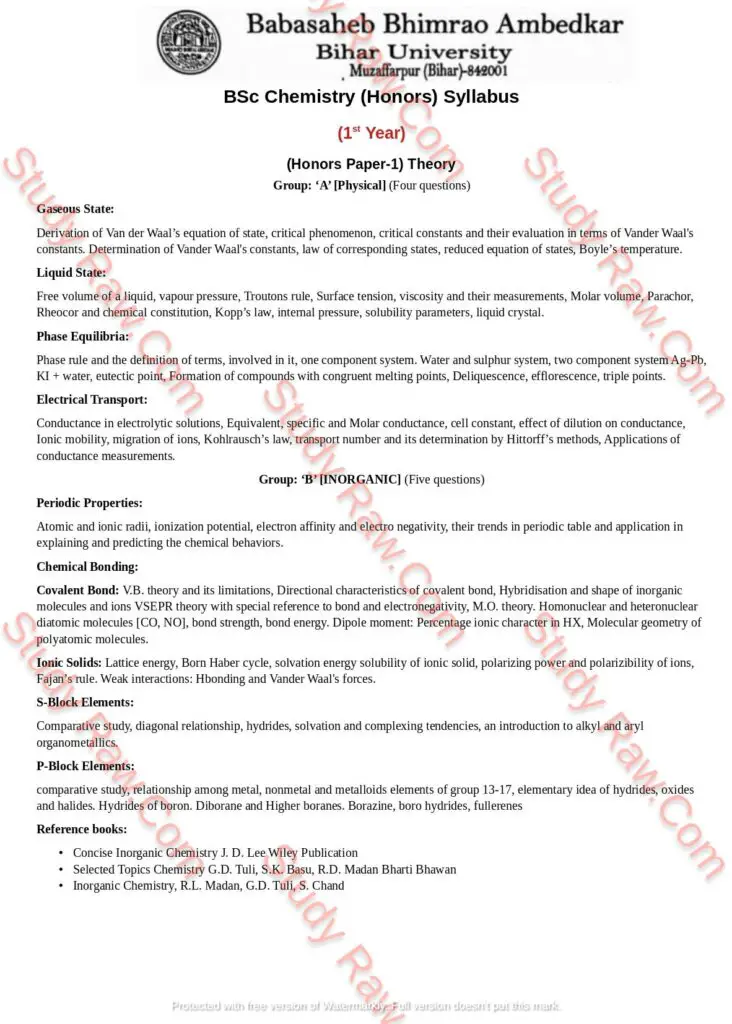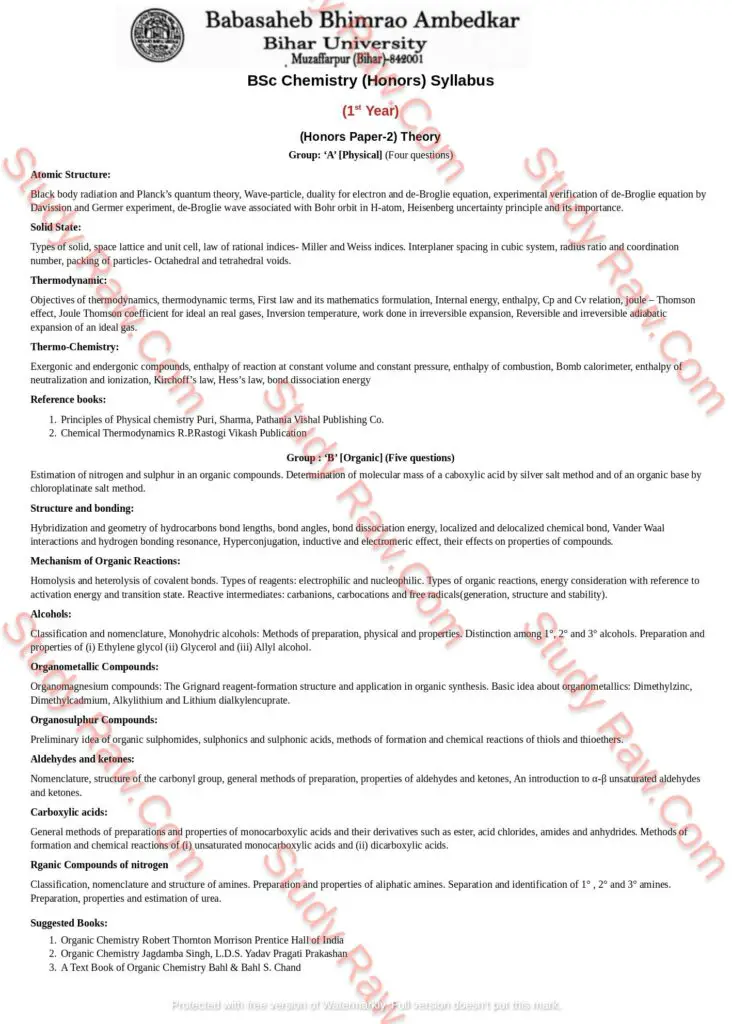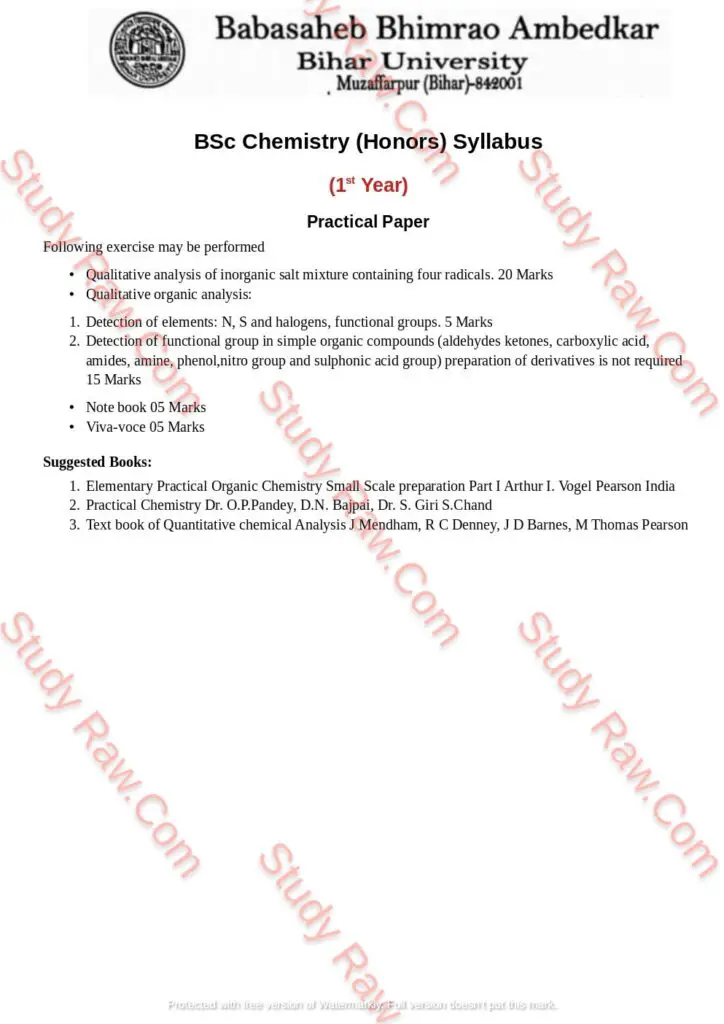BRABU BSc Chemistry Part-1 Syllabus/ Theory/ Practical
BRABU BSc Chemistry Part-1 Syllabus/ Theory/ Practical: Here we are writing all the UG (BA/ BSc / BCom) Syllabus of Babasaheb Bhimrao Ambedkar Bihar University. So All those students who are studding under this BRABU Bihar University can get their All Subjects Syllabus from this Website- www.studyorigin.in
Here we are providing you BSc Chemistry Honors Paper-1 and Honors Paper-2 Syllabus for Theory Paper and Practical Paper. These Papers are used to study in 1st Year of BSc Zoology Honors Subject. Each of which Paper there are 100 Marks Examination will be held. It has both Theory and Practical Papers.
BRABU BSc Chemistry (Honors) Part-1 Syllabus Details-
| University Name | Babasaheb Bhimrao Ambedkar Bihar University |
| Notice About | BSc Chemistry Part-1 Syllabus |
| Paper Number | Honors Paper-1 & Paper-1 |
| Paper Type | Theory and Practical |
| Academic Year | 1st Year |
BRABU BSc Chemistry (Honors Paper-1) Syllabus
Nine questions to be set. Five questions to be answered. Short answer type questions are recommended. There may be several parts in a question and different units may be mixed in questions. While setting questions the entire syllabus may be covered as far as practicable. Two questions to be answered from group ‘A’ and three questions to be answered from group ‘B’
Group: ‘A’ [Physical] (Four questions)
Gaseous State:
Derivation of Van der Waal’s equation of state, critical phenomenon, critical constants and their evaluation in terms of Vander Waal’s constants. Determination of Vander Waal’s constants, law of corresponding states, reduced equation of states, Boyle’s temperature.
Liquid State:
Free volume of a liquid, vapour pressure, Troutons rule, Surface tension, viscosity and their measurements, Molar volume, Parachor, Rheocor and chemical constitution, Kopp’s law, internal pressure, solubility parameters, liquid crystal.
Phase Equilibria:
Phase rule and the definition of terms, involved in it, one component system. Water and sulphur system, two component system Ag-Pb, KI + water, eutectic point, Formation of compounds with congruent melting points, Deliquescence, efflorescence, triple points.
Electrical Transport:
Conductance in electrolytic solutions, Equivalent, specific and Molar conductance, cell constant, effect of dilution on conductance, Ionic mobility, migration of ions, Kohlrausch’s law, transport number and its determination by Hittorff’s methods, Applications of conductance measurements.
Group: ‘B’ [INORGANIC] (Five questions)
Periodic Properties:
Atomic and ionic radii, ionization potential, electron affinity and electro negativity, their trends in periodic table and application in explaining and predicting the chemical behaviors.
Chemical Bonding:
Covalent Bond: V.B. theory and its limitations, Directional characteristics of covalent bond, Hybridisation and shape of inorganic molecules and ions VSEPR theory with special reference to bond and electronegativity, M.O. theory. Homonuclear and heteronuclear diatomic molecules [CO, NO], bond strength, bond energy. Dipole moment: Percentage ionic character in HX, Molecular geometry of polyatomic molecules.
Ionic Solids: Lattice energy, Born Haber cycle, solvation energy solubility of ionic solid, polarizing power and polarizibility of ions, Fajan’s rule. Weak interactions: Hbonding and Vander Waal’s forces.
S-Block Elements:
Comparative study, diagonal relationship, hydrides, solvation and complexing tendencies, an introduction to alkyl and aryl organometallics.
P-Block Elements:
comparative study, relationship among metal, nonmetal and metalloids elements of group 13-17, elementary idea of hydrides, oxides and halides. Hydrides of boron. Diborane and Higher boranes. Borazine, boro hydrides, fullerenes
Reference books:
- Concise Inorganic Chemistry J. D. Lee Wiley Publication
- Selected Topics Chemistry G.D. Tuli, S.K. Basu, R.D. Madan Bharti Bhawan
- Inorganic Chemistry, R.L. Madan, G.D. Tuli, S. Chand
BRABU BSc Chemistry (Honors Paper-2) Syllabus
Nine questions to be set. Five questions to be answered. Short answer type questions are recommended. There may be several parts in a question and different units may be mixed in questions. While setting questions the entire syllabus may be covered as far as practicable. Two questions to be answered from group ‘A’ and three questions to be answered from group ‘B’
Group: ‘A’ [Physical] (Four questions)
Atomic Structure:
Black body radiation and Planck’s quantum theory, Wave-particle, duality for electron and de-Broglie equation, experimental verification of de-Broglie equation by Davission and Germer experiment, de-Broglie wave associated with Bohr orbit in H-atom, Heisenberg uncertainty principle and its importance.
Solid State:
Types of solid, space lattice and unit cell, law of rational indices- Miller and Weiss indices. Interplaner spacing in cubic system, radius ratio and coordination number, packing of particles- Octahedral and tetrahedral voids.
Thermodynamic:
Objectives of thermodynamics, thermodynamic terms, First law and its mathematics formulation, Internal energy, enthalpy, Cp and Cv relation, joule – Thomson effect, Joule Thomson coefficient for ideal an real gases, Inversion temperature, work done in irreversible expansion, Reversible and irreversible adiabatic expansion of an ideal gas.
Thermo-Chemistry:
Exergonic and endergonic compounds, enthalpy of reaction at constant volume and constant pressure, enthalpy of combustion, Bomb calorimeter, enthalpy of neutralization and ionization, Kirchoff’s law, Hess’s law, bond dissociation energy
Reference books:
- Principles of Physical chemistry Puri, Sharma, Pathania Vishal Publishing Co.
- Chemical Thermodynamics R.P.Rastogi Vikash Publication
Group : ‘B’ [Organic] (Five questions)
Estimation of nitrogen and sulphur in an organic compounds. Determination of molecular mass of a caboxylic acid by silver salt method and of an organic base by chloroplatinate salt method.
Structure and bonding:
Hybridization and geometry of hydrocarbons bond lengths, bond angles, bond dissociation energy, localized and delocalized chemical bond, Vander Waal interactions and hydrogen bonding resonance, Hyperconjugation, inductive and electromeric effect, their effects on properties of compounds.
Mechanism of Organic Reactions:
Homolysis and heterolysis of covalent bonds. Types of reagents: electrophilic and nucleophilic. Types of organic reactions, energy consideration with reference to activation energy and transition state. Reactive intermediates: carbanions, carbocations and free radicals(generation, structure and stability).
Alcohols:
Classification and nomenclature, Monohydric alcohols: Methods of preparation, physical and properties. Distinction among 1°, 2° and 3° alcohols. Preparation and properties of (i) Ethylene glycol (ii) Glycerol and (iii) Allyl alcohol.
Organometallic Compounds:
Organomagnesium compounds: The Grignard reagent-formation structure and application in organic synthesis. Basic idea about organometallics: Dimethylzinc, Dimethylcadmium, Alkylithium and Lithium dialkylencuprate.
Organosulphur Compounds:
Preliminary idea of organic sulphomides, sulphonics and sulphonic acids, methods of formation and chemical reactions of thiols and thioethers.
Aldehydes and ketones:
Nomenclature, structure of the carbonyl group, general methods of preparation, properties of aldehydes and ketones, An introduction to α-β unsaturated aldehydes and ketones.
Carboxylic acids:
General methods of preparations and properties of monocarboxylic acids and their derivatives such as ester, acid chlorides, amides and anhydrides. Methods of formation and chemical reactions of (i) unsaturated monocarboxylic acids and (ii) dicarboxylic acids.
Rganic Compounds of nitrogen
Classification, nomenclature and structure of amines. Preparation and properties of aliphatic amines. Separation and identification of 1° , 2° and 3° amines. Preparation, properties and estimation of urea.
Suggested Books:
- Organic Chemistry Robert Thornton Morrison Prentice Hall of India
- Organic Chemistry Jagdamba Singh, L.D.S. Yadav Pragati Prakashan
- A Text Book of Organic Chemistry Bahl & Bahl S. Chand
BRABU BSc Chemistry Honors Practical Paper Syllabus
Following exercise may be performed
- Qualitative analysis of inorganic salt mixture containing four radicals. 20 Marks
- Qualitative organic analysis:
- Detection of elements: N, S and halogens, functional groups. 5 Marks
- Detection of functional group in simple organic compounds (aldehydes ketones, carboxylic acid, amides, amine, phenol,nitro group and sulphonic acid group) preparation of derivatives is not required 15 Marks
- Note book 05 Marks
- Viva-voce 05 Marks
Suggested Books:
- Elementary Practical Organic Chemistry Small Scale preparation Part I Arthur I. Vogel Pearson India
- Practical Chemistry Dr. O.P.Pandey, D.N. Bajpai, Dr. S. Giri S.Chand
- Text book of Quantitative chemical Analysis J Mendham, R C Denney, J D Barnes, M Thomas Pearson
BRABU BSc Chemistry Honors Part-1 Syllabus Marks Distribution:
| BSc Chemistry Theory Paper-1 | Full Marks: 75 |
| BSc Chemistry Theory Paper-2 | Full Marks: 75 |
| BSc Chemistry Practical Paper | Full Marks: 50 |
| Exam Time for Theory Paper Exam | 3 Hours |
NOTE: Marks Distribution may be different for different University. Please keep confirm by checking previous year Question Paper about Exam Pattern.
BRABU BSc Chemistry (Honors Paper-1) Syllabus Image-

BRABU BSc Chemistry (Honors Paper-2) Syllabus Image-

BRABU BSc Chemistry (Practical Paper) Syllabus Image-

Study Origin: Bihar Educational News Social Media –
| Social Media Type | Online Links |
|---|---|
| YouTube | Click here |
| Telegram | Click here |
| Click here | |
| Click here | |
| Facebook Profile | Click here |
| Facebook Page | Click here |
| Facebook Group | Click here |
| Click here |
How many Honors Paper is present in BRABU BSc Chemistry 1st Year?
In BSc Chemistry 1st Year Students have to study two honors papers named. Honors Paper-1 and Honors Paper-2
How many Practical Paper is present in BRABU BSc Chemistry 1st Year?
There is only one Practical Paper is present in BSc Chemistry Honors 1st Year
